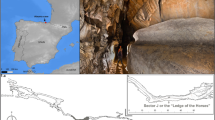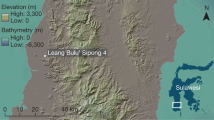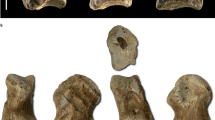Abstract
The ability to produce recognizable depictions of objects from the natural world—known as figurative art—is unique to Homo sapiens and may be one of the cognitive traits that separates our species from extinct hominin relatives. Surviving examples of Pleistocene figurative art are generally confined to rock art or portable three-dimensional works (such as figurines) and images engraved into the surfaces of small mobile objects. These portable communicative technologies first appear in Europe some 40 thousand years ago (ka) with the arrival of H. sapiens. Conversely, despite H. sapiens having moved into Southeast Asia–Australasia by at least 65 ka, very little evidence for Pleistocene-aged portable art has been identified, leading to uncertainties regarding the cultural behaviour of the earliest H. sapiens in this region. Here, we report the discovery of two small stone ‘plaquettes’ incised with figurative imagery dating to 26–14 ka from Leang Bulu Bettue, Sulawesi. These new findings, together with the recent discovery of rock art dating to at least 40 ka in this same region, overturns the long-held belief that the first H. sapiens of Southeast Asia–Australasia did not create sophisticated art and further cements the importance of this behaviour for our species’ ability to overcome environmental and social challenges.
This is a preview of subscription content, access via your institution
Access options
Access Nature and 54 other Nature Portfolio journals
Get Nature+, our best-value online-access subscription
$29.99 / 30 days
cancel any time
Subscribe to this journal
Receive 12 digital issues and online access to articles
$119.00 per year
only $9.92 per issue
Buy this article
- Purchase on Springer Link
- Instant access to full article PDF
Prices may be subject to local taxes which are calculated during checkout





Similar content being viewed by others
Data availability
The artefacts reported here are currently curated at the Australian Research Centre for Human Evolution, Griffith University, Nathan, Australia. They will return to Indonesia at the conclusion of the project where they will be given accession numbers and be curated in Makassar by Balai Arkeologi Sulawesi Selatan.
References
McBrearty, S. & Brooks, A. S. The revolution that wasn’t: a new interpretation of the origin of modern human behavior. J. Hum. Evol. 39, 453–563 (2000).
Shea, J. J. Homo sapiens is as Homo sapiens was. Curr. Anthropol. 52, 1–35 (2011).
Colagè, I. & d’Errico, F. Culture: the driving force of human cognition. Top. Cogn. Sci. 11, 1–19 (2018).
d’Errico, F. et al. Archaeological evidence for the emergence of language, symbolism, and music—an alternative multidisciplinary perspective. J. World Prehist. 17, 1–70 (2003).
Kuhn, S. L. & Stiner, M. C. in Rethinking the Human Revolution: New Behavioural and Biological Perspectives on the Origin and Dispersal of Modern Humans (eds. Mellars, P., Boyle, K., Bar-Yosef, O. & Stringer, C.) Chapter 4 (MacDonald Institute of Archaeology, 2007).
Mellet, E. et al. Neuroimaging supports the representational nature of the earliest human engravings. R. Soc. Open Sci. 6, 190086 (2019).
Clarkson, C. et al. Human occupation of northern Australia by 65,000 years ago. Nature 547, 306–310 (2017).
Westaway, K. et al. An early modern human presence in Sumatra 73,000–63,000 years ago. Nature 548, 322–325 (2017).
Brumm, A. & Moore, M. W. Symbolic revolutions and the Australian archaeological record. Camb. Archaeol. J. 15, 157–175 (2005).
Dennell, R. & Porr, M. Southern Asia, Australia and the Search for Human Origins (Cambridge Univ. Press, 2014).
Langley, M. C., Clarkson, C. & Ulm, S. From small holes to grand narratives: the impact of taphonomy and sample size on the modernity debate in Australia and New Guinea. J. Hum. Evol. 61, 197–208 (2011).
Wright, D., Langley, M. C., Litster, M., & May, S. K. in The Archaeology of Portable Art: Southeast Asian, Pacific, and Australian Perspectives (eds. Langley, M. C., Litster, M., Wright, D. & May, S. K.) Chapter 1 (Routledge, 2018).
Mellars, P. Going east: new genetic and archaeological perspectives on the modern human colonization of Eurasia. Science 313, 796–800 (2006).
Mellars, P., Gori, K. C., Carr, M., Soares, P. A. & Richards, M. B. Genetic and archaeological perspectives on the initial modern human colonization of southern Asia. Proc. Natl Acad. Sci. USA 110, 10699–10704 (2013).
Glover, I. C. Leang Burung 2: an Upper Palaeolithic rock shelter in south Sulawesi, Indonesia. Mod. Quat. Res. SE Asia 6, 1–38 (1981).
Aubert, M. et al. Pleistocene cave art from Sulawesi, Indonesia. Nature 514, 223–227 (2014).
Li, B. et al. IRSL dating of fast-fading sanidine feldspars from Sulawesi, Indonesia. Anc. TL 34, 1–13 (2016).
Brumm, A. et al. Early human symbolic behavior in the Late Pleistocene of Island Southeast Asia. Proc. Natl Acad. Sci. USA 114, 4105–4110 (2017).
Groves, C. & Grubb, P. Ungulate Taxonomy (Johns Hopkins Univ. Press, 2011).
Burton, J. A., Hedges, S. & Mustari, A. H. The taxonomic status, distribution and conservation of the lowland anoa Bubalus depressicornis and mountain anoa Bubalus quarlesi. Mammal Rev. 35, 25–50 (2005).
Groves, C. Systematics of the Anoa (Mammalia, Bovidae). Beaufortia 17, 1–12 (1969).
Rozzi, R. A new extinct dwarfed buffalo from Sulawesi and the evolution of the subgenus Anoa: an interdisciplinary perspective. Quat. Sci. Rev. 157, 188–205 (2017).
Davidson, D. S. Notes on the pictographs and petroglyphs of Western Australia and a discussion on their affinities with appearances elsewhere on the continent. Proc. Am. Philos. Soc. 96, 76–117 (1952).
Schobinger, J. The Ancient Americans Vol. 1 (Routledge, 2002).
Willcox, A. R. The Rock Art of Africa (Croom Helm, 1984).
Diaz-Granados, C. & Duncan J. R. The Rock-Art of Eastern North America (Univ. of Alabama Press, 2004).
Flood, J. Rock Art of the Dreamtime (Angus and Robertson, 1997).
Orton, J. Geometric rock art in western South Africa and its implications for the spread of early herding. S. Afr. Archaeol. Bull. 68, 27–40 (2013).
Sterelny, K. From hominins to humans: how sapiens became behaviourally modern. Phil. Trans. R. Soc. B 366, 20100301 (2011).
Conard, N. J. A female figurine from the basal Aurignacian of Hohle Fels Cave in southwestern Germany. Nature 459, 248–252 (2009).
Donald, M. Origins of Modern Mind (Harvard Univ. Press, 1991).
Gamble, C. The Palaeolithic Societies of Europe (Cambridge Univ. Press, 1999).
Noble, W. & Davidson, I. The evolutionary emergence of modern human behaviour. Man 26, 223–253 (1991).
Veth, P., Stern, M., McDonald, J., Balme, J. & Davidson, I. in Information and its Role in Hunter-Gatherer Bands (eds. Whallon, R., Lovis, W. A. & Hitchcock, R. K.) Chapter 9 (Cotsen Institute of Archaeology Press, 2011).
Balme, J., Davidson, I., McDonald, J., Stern, N. & Veth, P. Symbolic behaviour and the peopling of the southern arc route to Australia. Quat. Int. 202, 59–68 (2009).
Habgood, P. J. & Franklin, N. The revolution that didn’t arrive: a review of Pleistocene Sahul. J. Hum. Evol. 55, 187–222 (2008).
Conard, N. J. Palaeolithic ivory sculptures from southwestern Germany and the origins of figurative art. Nature 426, 830–832 (2003).
Bourrillon, R. et al. A new Aurignacian engraving from Abri Blanchard, France: implications for understanding Aurignacian graphic expression in Western and Central Europe. Quat. Int. 491, 46–64 (2018).
Yaroshevich, A. et al. A unique assemblage of engraved plaquettes from Ein Qashish South, Jezreel Valley, Israel: figurative and non-figurative symbols of Late Pleistocene hunters-gatherers in the Levant. PLoS ONE 11, e0160687 (2016).
Richter, D. et al. The age of the hominin from Jebel Irhoud, Morocco, and the origins of the Middle Stone Age. Nature 546, 293–296 (2017).
White, R. Prehistoric Art: The Symbolic Journey of Humankind (Abrams, 2003).
Graziosi, P. Palaeolithic Art (Faber and Faber, 1960).
Wedage, O. et al. Specialized rainforest hunting by Homo sapiens ~45,000 years ago. Nat. Commun. 10, 739 (2019).
Acknowledgements
The 2017–2018 excavations at LBB were supported by an Australian Research Council (ARC) Future Fellowship grant (no. FT160100119) awarded to A.B., along with generous funding from Griffith University. The funders had no role in study design, data collection and analysis, decision to publish or preparation of the manuscript. For authorizing the Indonesian field research, we thank Director of ARKENAS, I. Made Geria, Head of Balai Arkeologi Makassar, I. Mahmud and Head of Balai Pelestarian Cagar Budaya, L. Aksa, along with the State Ministry of Research and Technology, which issued the relevant research permits.
Author information
Authors and Affiliations
Contributions
A.B. directed the excavation of LBB with B.H., A.A.O., B.B., I.S., P.H.S. and R.L. acting as counterparts and collaborators on the investigation of the Sulawesi sites being explored. D.M. created the micro-CT images included in this manuscript. M.C.L. undertook the qualitative and quantitative analysis of the presented artefacts. M.C.L. and A.B. wrote the manuscript, with contributions from the other authors.
Corresponding author
Ethics declarations
Competing interests
The authors declare no competing interests.
Additional information
Editor recognition statement Primary Handling Editor: Stavroula Kousta.
Publisher’s note Springer Nature remains neutral with regard to jurisdictional claims in published maps and institutional affiliations.
Supplementary information
Supplementary Information
Supplementary notes, data, references and Supplementary Figs. 1–20.
Rights and permissions
About this article
Cite this article
Langley, M.C., Hakim, B., Agus Oktaviana, A. et al. Portable art from Pleistocene Sulawesi. Nat Hum Behav 4, 597–602 (2020). https://doi.org/10.1038/s41562-020-0837-6
Received:
Accepted:
Published:
Issue Date:
DOI: https://doi.org/10.1038/s41562-020-0837-6
This article is cited by
-
Scratching the Surface: Engraved Cortex as Portable Art in Pleistocene Sulawesi
Journal of Archaeological Method and Theory (2020)



